英语必修一直接引语和间接引语
- 格式:doc
- 大小:84.00 KB
- 文档页数:4
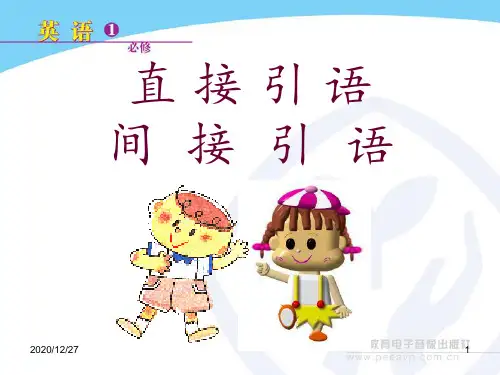
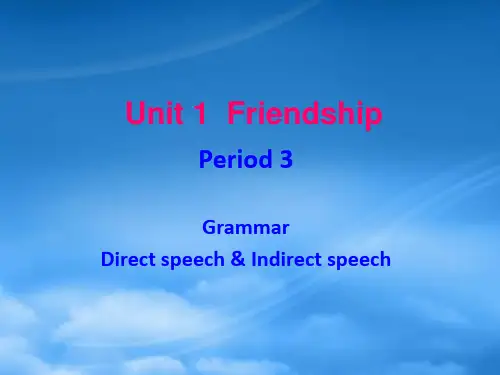

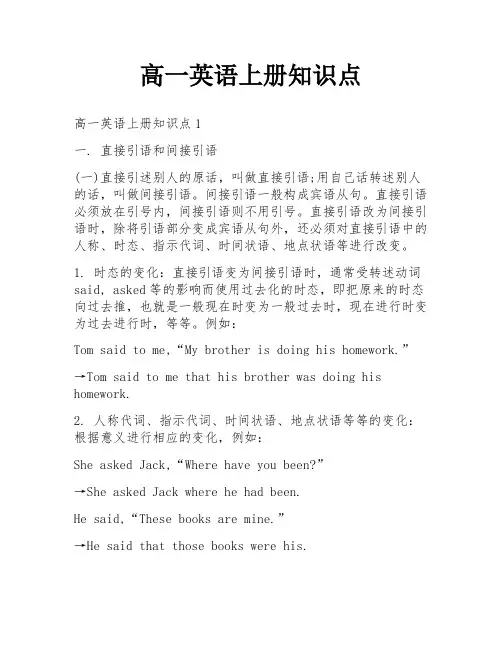
高一英语上册知识点高一英语上册知识点1一. 直接引语和间接引语(一)直接引述别人的原话,叫做直接引语;用自己话转述别人的话,叫做间接引语。
间接引语一般构成宾语从句。
直接引语必须放在引号内,间接引语则不用引号。
直接引语改为间接引语时,除将引语部分变成宾语从句外,还必须对直接引语中的人称、时态、指示代词、时间状语、地点状语等进行改变。
1. 时态的变化:直接引语变为间接引语时,通常受转述动词said, asked等的影响而使用过去化的时态,即把原来的时态向过去推,也就是一般现在时变为一般过去时,现在进行时变为过去进行时,等等。
例如:Tom said to me,“My brother is doing his homework.”→Tom said to me that his brother was doing his homework.2. 人称代词、指示代词、时间状语、地点状语等等的变化:根据意义进行相应的变化,例如:She asked Jack,“Where have you been?”→She asked Jack where he had been.He said,“These books are mine.”→He said that those books were his.(二)直接引语改为间接引语时,都使用陈述语序,但是因为原句的句式不同,所以变成间接引语时所用的连词会有所不同。
直接引语如果是一般疑问句,用连接词whether或if;如果是特殊疑问句,则用疑问词引导间接引语。
转述的动词一般用asked,可以在其后加上一个间接宾语me, him, her, us等。
如:She said,“Is your father at home?”→She asked me if/whether my father was at home.“What do you do every Sunday?”My friend asked me.→My friend asked me what I did every Sunday.直接引语如果是祈使句,改为间接引语时,要将祈使句的动词原形变为带to的不定式,并在不定式的前面根据原句的语气(即请求或命令)加上ask, tell, order等动词,如果祈使句为否定式,则在不定式前加not。

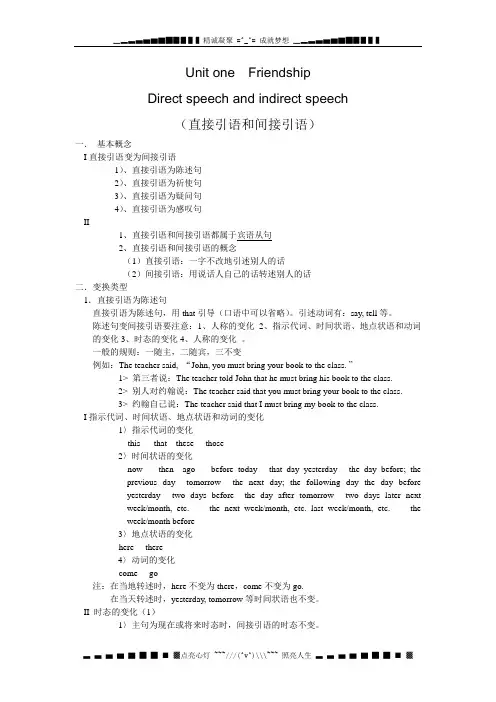
Unit one FriendshipDirect speech and indirect speech(直接引语和间接引语)一.基本概念I直接引语变为间接引语1)、直接引语为陈述句2)、直接引语为祈使句3)、直接引语为疑问句4)、直接引语为感叹句II1、直接引语和间接引语都属于宾语从句2、直接引语和间接引语的概念(1)直接引语:一字不改地引述别人的话(2)间接引语:用说话人自己的话转述别人的话二.变换类型1.直接引语为陈述句直接引语为陈述句,用that引导(口语中可以省略)。
引述动词有:say, tell等。
陈述句变间接引语要注意:1、人称的变化2、指示代词、时间状语、地点状语和动词的变化3、时态的变化4、人称的变化。
一般的规则:一随主,二随宾,三不变例如:The teacher said, “John, you must bring your book to the class. ”1> 第三者说:The teacher told John that he must bring his book to the class.2> 别人对约翰说:The teacher said that you must bring your book to the class.3> 约翰自己说:The teacher said that I must bring my book to the class.I指示代词、时间状语、地点状语和动词的变化1〉指示代词的变化this---- that these----those2〉时间状语的变化now---- then ago---- before today----that day yesterday----the day before; theprevious day tomorrow----the next day; the following day the day beforeyesterday----two days before the day after tomorrow----two days later nextweek/month, etc.----the next week/month, etc. last week/month, etc.----theweek/month before3〉地点状语的变化here----there4〉动词的变化come----go注:在当地转述时,here不变为there,come不变为go.在当天转述时,yesterday, tomorrow等时间状语也不变。
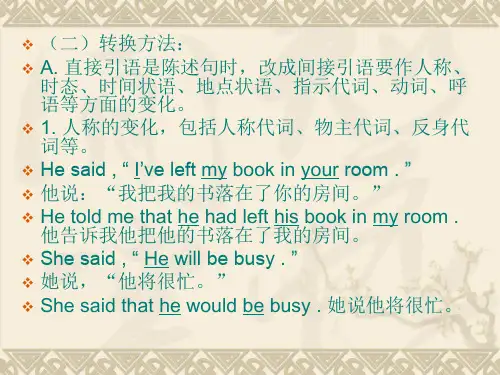
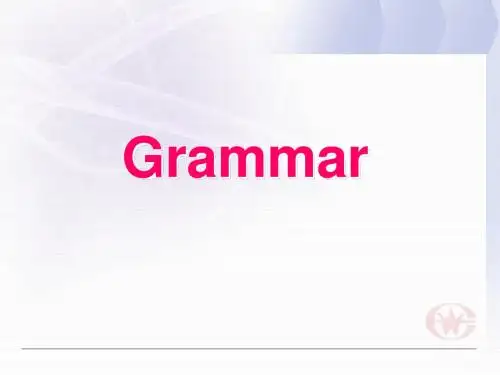

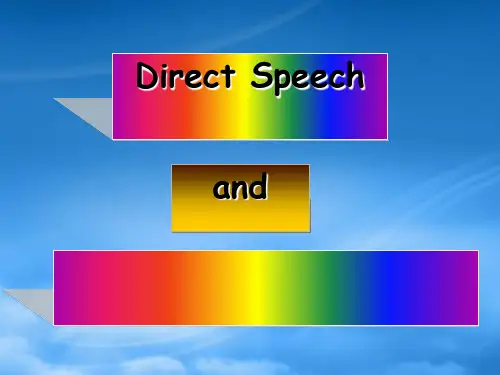
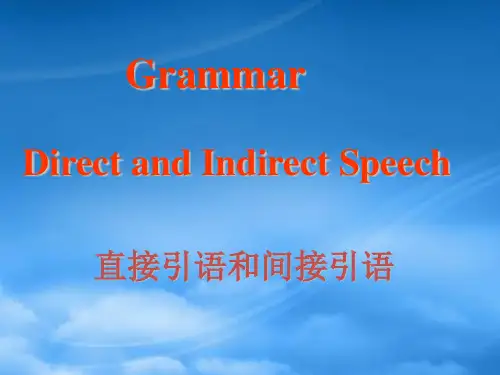
Unit1 Friendship语法直接引语和间接引语概念引入:我们先看下面的句子:1.John said, “I'm going to London with my father.”约翰说:“我要和父亲到伦敦去。
”2.She said, "Do you often come here to read newspapers?"她说:“你经常来这儿看报吗?3.I asked him, "Will you stay at home or go to a film tonight?"我问他:“你今晚是待在家还是去看电影?”从上述例句看出:引号内是直接引用别人的原话,这种句子为直接引语。
1.John said that he was going to London with his father.约翰说,他要和他父亲去伦敦。
2.She asked me if (whether)I often went there to read newspapers.她问我是否经常去那儿看报。
3.I asked him whether he would stay at home or go to a film that night.我问他那天晚上是待在家还是去看电影。
从第二组的例句看出,都是别人的原话进行了转述。
在转述中,人称、时态、代词、时间状语的表达都有所变化。
用法讲解课文原句回放1. “I don’t want to set down a series of facts in a diary,” said Anne. (Direct speech)安妮说:“我不想在日记中记流水账。
”Anne sa id that she didn’t want to set dow n a series of facts in a diary. (Indirect speech)安妮说她不想在日记中记流水账。
Grammar Direct speech & Indirect speech
一. 直接引语(Direct speech)和间接引语(Indirect speech)
1. 直接引语(Direct speech):讲述别人的原话,并把它放在引号里。
2. 间接引语(Indirect speech):用自己的话转述别人的话,并且不能用引号。
Anne said: “ I am crazy about nature.” (Direct speech)
She said that she was crazy about nature. (Indirect speech)
二. 变间接引语时注意的要点
1.人称的变化(直接引语里的第一人称和第二人称,变间接引语时,人称要做相应调整。
)
1. She said: “I am hungry.”
She said she was hungry.
2. Mum said to me:“ Y ou can do it yourself.”
Mum told me that I could do it myself.
3. Mr. Smith said, “He is a good worker.’’
Mr. Smith said that he was a good worker.
Exercises (Have a try) :
1. Jack said to me, “You look worried today.”
Jack told me that ________ looked worried that day.
2. We said to her, “They’re cleaning the room.”
We told her that __________ were cleaning the room.
3. Mr. Black said, “I have walked a long way.”
Mr. Black said that __________ had walked a long way.
2.时态变化
直接引语变间接引语时,间接引语的时态要与主句的时态一致。
1). 主句为一般现在时, 现在完成时或一般将来时的时候, 间接引语时态不变。
He says: “I treat you as my son.”
He says that he treats me as his son.
1。